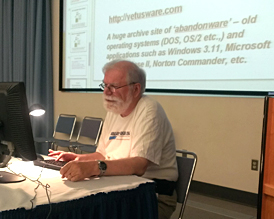By Jim Ritterbusch On October 1st, Bruce Preston presented “Virtual Machines for Backward Compatibility (and a lot more)“. He suggested a number of reasons why one might want virtualization, such as support for legacy applications, obsolete hardware, regression testing, and more. Using the analogy of a Windows calculator being a “virtual calculator” that fulfills all of the functions of a real calculator, Bruce explained the principal of virtualization being implemented completely in software. Detailing the normal PC boot process, Bruce explained how virtualization is different from dual-booting. He elaborated on many facets of the boot process. He walked us through the virtualization from mainframes through mini-computers and ultimately on desktop PCs. He provided us details on the software/hardware interface, the hardware abstraction layer, device drivers, and tied it all together into a conceptual diagram of a physical computer. Bruce then introduced the hypervisor, the housekeeper that keeps all of the virtual components in their proper places. He showed us various different hypervisors. For the purpose of this demonstration, he focused on the VirtualBox hypervisor, freeware published by Oracle. He tied the virtual PC back to the conceptual diagram presented earlier. He then listed the steps to create a virtual machine using VirtualBox, whether the VM was Windows 8, Vista, Windows 95, or even DOS. Bruce elaborated on options for internet connections to the outside world, as well as a Disk2VHD utility that can take an existing single-boot Windows installation and convert it to a VM, with that version of Windows running as the guest underneath. Bruce provided some resource links, such as http://www.virtualbox.org and http://www.vetusware.com. He explained that there are some compatibility issues with old software applications, especially those that used code which directly accessed hardware. A primary example was the original Microsoft Flight Simulator, which was tied to early PCs' 4.7 MHz clocks. Running on a modern machine at 3.4 GHz would cause your Cessna 150 to fly 700 times faster and crash immediately on takeoff! Following the pitch, Bruce presented a live demonstration of installing a virtual machine on his existing computer running VirtualBox. For the VM, he selected Microsoft DOS 6.2, due to the quick installation time. This was accomplished in a few minutes. A question and answer period ensued. All-in-all, an informative and interesting presentation. Thanks, Bruce! Bruce's presentation is available in PDF format on the DACS download page, at http://dacs.org/pdf/VM_Present_v1_DACS.pdf.
|
 Click Here |
 |
 |
DacsGear! |
 DACS General Meeting
DACS General Meeting